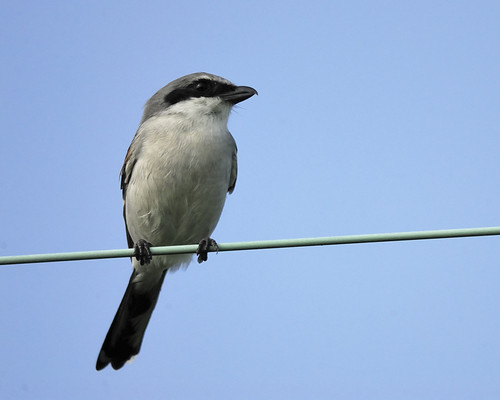tags: Loggerhead Shrike, Lanius ludovicianus, birds, nature, Image of the Day
[Mystery bird] Loggerhead Shrike, Lanius ludovicianus, photographed at Smith Point, Texas. [I will identify this bird for you tomorrow]
Image: Joseph Kennedy, 29 August 2008 [larger view].
Nikon D200, Kowa 883 telescope TSN-PZ camera eyepiece 1/500s f/8.0 at 1000.0mm iso400.
- Log in to post comments


A shrike!! I would say the best experience I had while living in Houston for most of a year was spotting one in the courtyard of my building. Great photo!
I'll guess Loggerhead Shrike?
what characters make you think this is a loggerhead shrike?
Besides the location, well outside the range of the Northern, the small bill to head ratio makes it most likely a loggerhead.
Ray
Houston, TX
This looks like a chicadee.
Except it's missing it's black chin thingy.
And the beak is all wrong... so not a chicadee.
The long bill suggests it is a Northern Shrike, though it generally may be way south of its usual range.
Definitely a Shrike. If I saw it this side of the Atlantic I'd say it was a Great Grey Shrike Lanius excubitor (and I'd also be very pleasantly surprised), are they found in N America as well?
seconding loggerhead shrike.
The white eyebrow on this fellow is fainter and shorter than the northern. His beak's not that long...
The black bar under his eye is thicker than a Northern, IMO.
This bird would be happy to eat a chickadee for lunch, despite being kind of cute! Supposedly the Loggerhead is the one that has the 'cute head' though, more like a chickadee. I think this shrike has a more flattened head, longer bill, so I'm voting Northern Shrike.
Shrikes may be passerines, but they catch small birds and other animals with their sharp talons and skewer the prey on thorns or barbed wire to hold while they eat them.
I really have trouble with these two North American species still...I -think- I see barring barely on the bird's chest above, which is a Northern Shrike thing. Hope I didn't just brainwash myself into the wrong ID. Going through books here I learned there are 2 shrikes in the New World but a LOT in the old world, the Lesser Grey Shrike (Lanius minor) of South Africa also looks similar. But this is Texas, probably in the winter and that's totally possible it's a Northern Shrike.
Loggerhead shrike. I agree with Lindsay that the beak really isn't that long.
It's Bob.
I read it here:
http://www.reddit.com/r/pics/comments/70jm4/identify_this_bird_image/
Definitely a shrike, and I'm going to go with Loggerhead. Northern would be far out of its range and would rate an RBA, and the thick black mask says Loggerhead to me.
No need to wait for the official reveal, my Firefox 3 on Mac doesn't show the picture, but clicking on the box where teh pic oughta be takes me to Mr. Kennedy's Flickr page where it says Loggerhead Shrike. Dang. I also see that the previous one was the Common Nighthawk, and I had been wondering about that. He's got some great shots, doesn't he? Maybe I need to glue one o them Kowa 883 telescopes to my camera. Great series, thanks. rb
Definitely a Loggerhead Shrike. They were common in the fields near my home in Phoenix and I'd often find lizards they had caught impaled on thorns there. We only have Northerns where I am now in upstate NY, but only rarely in the winter.
I have spent happy afternoons at the Smith Point hawk watch platform in the autumn and at the surrounding wildflowers and greenery. Once in the hawk-watch parking lot I saw a common green darner dragonfly male dispatch two other males by violent and noisy in-flight collisions, after which the aggressor landed to eat the abdomen of one of its victims.
Sssh. You'll blow my cover.
This bird is attractive enough as it is. Why on Earth would it want to go overboard with the eye make-up? Is it some sort of Gothhawk?
Just kidding. That overhang on the upper beak made me think vaguely of an actor, but I can't for the life of me nail down which actor or which movie I saw him in.